WILL THE TRUE BALSAM PLEASE STAND UP?
/8 Comments/in Design/by Lee ReichCold Enough for Balsam Fir?
Ah, to sit by the fire on a cold winter’s eve. The fire’s warmth suffuses me with somnolence and drives into the air a resinous, woodsy aroma from my fresh cut balsam fir branches draped about the room or steaming on the woodstove.
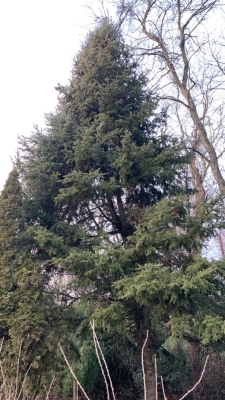
Balsam fir (Abies balsamea) would be an oddity amongst my plants. Here in the colder part of Zone 5, blackberries and some of my grapes have been pushed to their northern limits. Balsam fir would be unique in being a plant pushed to its southern limit. Most of my plants require well-drained soils. Balsam fir grows in well-drained soil, but it also will grow in swampy land, even very acidic (pH 5.0-6.0), swampy land
Balsam fir is native from northern New England to the tundra and mountaintops further south. I live in lowland. In those cold, moist locales where they are native, the trees grow slowly to become dense, pyramidal spires 50 feet tall with dark, shiny green, flattened needles. (Flattened needles are one way to distinguish firs from spruces, Picea species, which have rounded needles.)
Long ago I realized that it might be just too hot here in summer to grow balsam fir. Numerous books that I consulted warned about the futility of trying to grow balsam fir where it’s not native. Excessive heat would cause the needles to fall prematurely, leaving the tree, after a few decades, thinned out and unkempt. The prognosis for successful growing of balsam fir here seemed slim.
Looking Elsewhere for Balsam
So I looked into getting my balsamy aromas elsewhere. Many plants yield “true” balsam, an aroma based on resins or oleoresins containing benzoic acid, cinnamic acid, or both. It’s too cold here, though, to grow most plants with this true balsam aroma: Balsam of Peru and Balsam of Tolu, from Myroxylon pereirae and M. balsamum, respectively, both trees of Central America; and liquid storax, a balsam from Liquidambar orientalis, a tree of Asia Minor, or from the Javanese plant Altingia excelsa.
One plant that is hardy here and does yield true balsam is sweetgum (Liquidambar styraciflua), which yields a balsam known as liquidambar, or copal, balsam. One problem with sweetgum is that it’s not an evergreen, so would not fill the bill for aromatic, winter greenery. A very pretty tree, though.
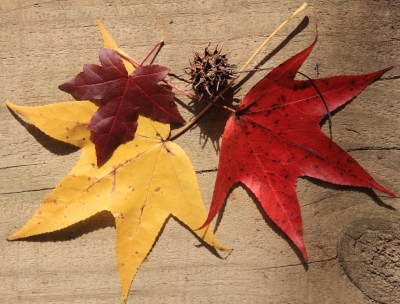
Sweetgum leaves & gumballs
I emphasized “true” balsam above because there are other balsams that are something less than “true,” which means they lack both benzoic and cinnamic acids. Balsam fir, whose balsam goes under the names of Canada balsam or Canada turpentine, does not yield a true balsam. Two other less-than-true balsams are Balm of Gilead (Mecca balsam), from the Middle Eastern plant Commiphora opobalsamum, and Gurjun balsam, from Indian species of Dipterocarpus. Here, cold would snuff out the life of either of these two plants.
The question of winter survival is a moot point for annual plants, and there are two annuals with “balsam” in their name. One of these is garden balsam, Impatiens balsamina, a relative of impatiens. I’ve occasionally grown this very pretty, old-fashioned annual, but don’t recall any woody, resinous odor.
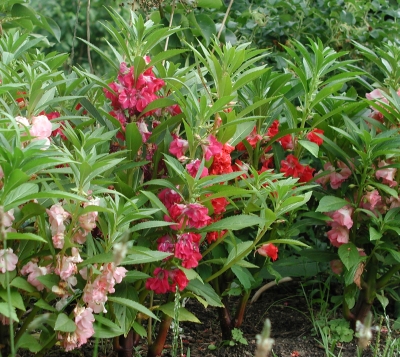
Garden balsam
Another balsam is balsam apple, Momordia balsamina, a vining cucumber relative which produces gherkin-shaped, yellowish red “apples.” I’ve never grown balsam apple, but doubt it has the desired aroma. None of its relatives that I have met — winter squashes, summer squashes, gourds, pumpkins, and luffas — have any odor of balsam.
I Give Balsam Fir a Try Anyway
So where did this leave me for my balsamy winter greenery? Eighty years ago I could have just gone out and bought a Christmas tree. Balsam fir was the most popular Christmas tree until the 1930s. Then, its general popularity was superseded by Scotch pine, which grows faster and holds its needles better.
Almost 30 years ago, the poor prognosis notwithstanding, I went ahead and planted a few foot-high balsam fir seedlings in a partly shaded rear portion of my yard. The soil there is rich and perfectly drained.
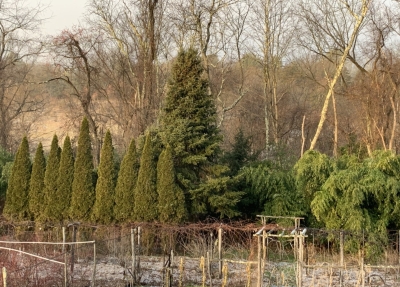
My 30-year-old balsam fir
Trees took well to their new home. Unfortunately, our puppy Stick liked to play with the trees, not to their benefit. Fortunately, one tree escaped his antics. That tree is still alive, actually more than alive. I can cut all the aromatic branches I want from this robust, now 36.4 foot high tree!
THERE ARE LOTS OF NUTS OUT THERE
/10 Comments/in Gardening/by Lee ReichI’ve written recently about how bountiful this past season has been with fruits. Well, botanically, at least, “fruits” includes “nuts.” More on this later.* The nut harvest was also abundant.
Except for last year, just about every year has been a good year for black walnuts. But this year, it didn’t take long to pick up and fill baskets quickly. After being husked, cleaned, and then left to cure in a squirrel-proof loft, I’ve started cracking them (with my ‘Master Nutcracker’). Large, plum, tasty nutmeats drop free from the shells.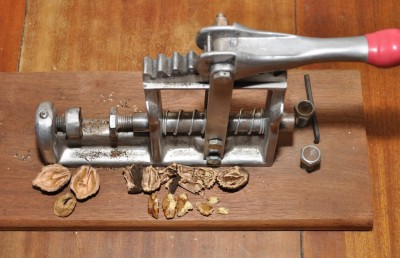
A Surprise Nut
What surprised me most was the harvest of English walnuts, botanically Juglans regia and also known as Persian walnuts. (The moniker “English” may be because of the significant role played by English sailors in distributing the nuts around the world.) Persia, or Eastern Europe is where this plant originated. Early on, humans introduced it to other parts of the world, including England, where Romans brought them 2,000 years ago. In the seventeenth century, the nuts and the wood of these trees was held in such high esteem in parts of Europe that a certificate of having planted a certain number of trees was needed before a man was allowed to marry.
Walnuts arrived in my garden in 2006, from seed from cold-hardy trees handed out at the Saratoga, New York meeting of the New York Nut Growers Association. I planted six of the walnut seeds. Because I have limited space and did not have high hopes for success, I arranged them in two stations of three plants each, with about 30 feet between the stations. In contrast to plants propagated asexually, such as by grafting or cuttings, plants grown from seed have some genetic diversity, in the same way you and your siblings are diverse from each other. I figured that eventually I would remove all but the one best tree at each station.
Despite the threat of frost killing blossoms in spring, walnut blight, defoliation by anthracnose disease in summer, and squirrels robbing all the nuts in fall, I was able to harvest plenty. Earlier in the season, I did notice that not all trees were bearing, or bearing well, so I cut down two of the slackers, one from each station.
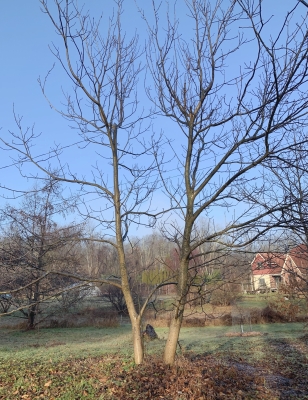
English walnut trees, 15 years ol
As far as differences in the nuts from tree to tree, it’s hard to say for sure at this point except to say the nuts on one of the trees may have been smaller. I’ll take a more quantitative look next year.
Walnut trees are known to be slow to come into bearing. There’s a Flanders folk saying that goes, “By the time the tree is big, the planter surely will be dead.” Well, I planted the trees from seed, they have borne and grown fairly big, and I’m not dead.
Still Waiting
Two nut trees whose first fruits I’m eagerly awaiting are both shellbark hickories (Carya laciniosa). Shagbark hickory (C. ovata) is very common around here and throughout eastern U.S., and is notable for its — duh! — very shaggy bark and tasty but small and hard to crack nuts. 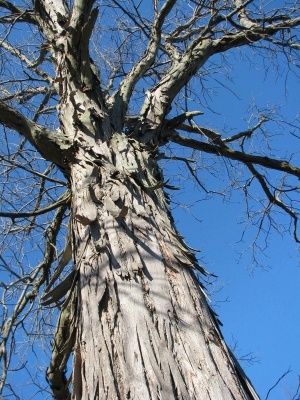 Shellbark hickory’s native range doesn’t extend as far east and south as shagbark’s. It’s found mostly along the Ohio and Mississippi Rivers, and bordering regions; nowhere, though, is it common. Also, the bark is less shaggy. The clincher is that shellbark nuts are much larger, around two inches long, and with thinner shells, so you get more bang for your buck with each nut you crack.
Shellbark hickory’s native range doesn’t extend as far east and south as shagbark’s. It’s found mostly along the Ohio and Mississippi Rivers, and bordering regions; nowhere, though, is it common. Also, the bark is less shaggy. The clincher is that shellbark nuts are much larger, around two inches long, and with thinner shells, so you get more bang for your buck with each nut you crack.
I planted the varieties Simpson and Grainger, both of which were selected for easy shelling. (Nut alert! I have since learned that Grainger is, in fact, a shagbark hickory, albeit a variety selected for large shells that crack out well.)
But how about some nuts! Simpson was planted in 2014 and Grainger in 2015, and both grow very slowly, about twelve inches per year. Bearing age is reputedly only a few years with a grafted trees, which, being named varieties, both were.
Nuts or no nuts, the trees are beautiful, their leaves turning a rich, golden yellow in autumn and, in winter, the stout branches punctuated and capped by fat buds.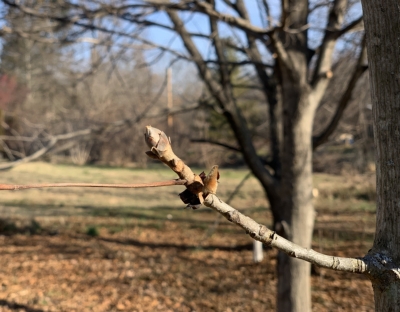
Botanical Nuts, and Not
*Back to fruits: A fruit, botanically, is any seed-bearing structure of a flowering plant formed from a ripened ovary along with seeds and other structures. A nut is a kind of fruit, in this case with a kernel surrounded by a hard nutshell. A nut’s shell does not open to release the kernel. So all nuts are fruits but all fruits aren’t nuts. Botanically speaking.
Some fruits commonly called nuts, such as almond, pistachio, Brazil nut, walnut, pecan, and macadamia, are not true nuts; they are dry drupes (which doesn’t sound very complimentary, does it?). A nut is a dry drupe whose kernel is enclosed within a stony pit surrounded by flesh and a skin. Think of a peach. That’s a (non)dry drupe.
Chestnut, hazelnut, oak, and birch are examples of true nuts.
That’s all botany. Out on the street, we call lots of things nuts. Peanuts, for example, which are actually legumes, just like peas and beans.
THE WISDOM OF SEEDS
/11 Comments/in Planning/by Lee ReichTweaking the View
Finally, today, I’m planting seeds. “Too late to plant seeds,” you say? Or, perhaps you’re thinking that it’s way too early, with the coldest days of the year still about a month away. Well, the seeds I’m talking about aren’t vegetable or flower seeds; they’re tree and shrub seeds.
Planting seeds is a way to get lots of new plants at little or no cost. The seeds I’m going to be planting are ones that I collected this past summer, fall, and yesterday.
I already grow way too many plants but I need these plants for a barrier. The rear of my property backs up to a rail trail which, from spring through fall, is a wall of greenery in a swath about twenty feet wide. Nothing special, just whatever popped up there naturally, mostly bush honeysuckles and some viburnums nearby with black cherries and ashes further in. Grape or bittersweet vines clamber up whatever they can latch onto. Leafless, now, these plants don’t present a particularly pretty sight.
What’s needed is some winter color and greenery. Closer in, I’m planning a screen with winterberry (Ilex verticillata), Meserve holly (Ilex x meserveae), and arborvitae (Thuja occidentalis, this one purchased as plants).
A couple of larger trees — black tupelo (Nyssa sylvatica) and red maple (Acer rubrum) — will beef up the naturally rag tag mix of trees further in.

I’m also sowing seeds of Nanking cherry (Prunus tomentosa). It’s one of my favorite large bushes for its spectacular show of pinkish white blossoms in early spring and its equally spectacular show and abundance of delicious, juicy, small cherries in summer. All on a carefree, very tough and very cold-hardy plant.
Seed: Awaken
Seeds of woody plants that ripen in early summer will sprout almost as soon as they touch down to soil. Red maple (Acer rubrum) is a good example of an early-ripening seed.
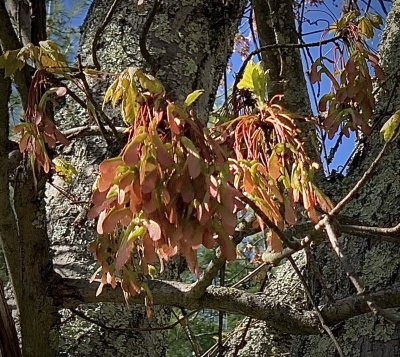
Red maple seeds in early summer
A friend collected some from his trees. I sowed them, they sprouted quickly, and I now have some healthy seedlings a foot or so tall.
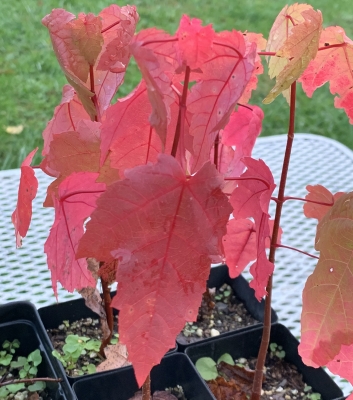
Red maple seedlings
Many woody plants bear seeds that don’t ripen until late summer or early fall. If these seeds sprouted as soon as they touched soil, the resulting tender, young sprouts would succumb to winter cold. To avoid this, they sit and wait until they feel that winter has passed. They gauge this, via their hormones, by the amount of cold they’ve experienced. Levels of the hormone abscisic acid, which keeps seeds dormant, decrease as cold wears on.
Seeds typically need exposure of one to two months, or about 1,000 hours, in a moist, cold environment before they can be convinced that it’s safe to sprout. Cold temperatures, between about 30 and 45 degrees Fahrenheit, not frigid temperatures, are what flick this switch. Depending on location, such temperatures might be experienced partly in fall and partly in spring, or mostly in fall.
Other types of dormancy might also need to be overcome before a seed will sprout. Some seeds have a separate dormancy for root growth, overcome with warm, moist conditions. Root growth must precede shoot growth.
Warm, moist conditions also may be initially needed for seeds with especially tough coats, to soften them or give microbes the opportunity to erode the surface.
Practical Matters
To start, I’m soaking the winterberry, holly, black tupelo, and Nanking cherry seeds in water for a couple of days, changing the water daily. Soaking does three things: First, it makes sure the seeds are well hydrated; second, it makes fruits fall apart to release their seeds; and third, it leaches out potential sprouting inhibitors. Sprouting inhibitors prevent seeds within moist, fleshy fruits from sprouting within.
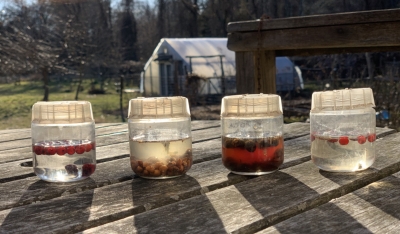
Winterberry, Nanking cherry, black tupelo, and holly seeds
In a couple of days, I’ll plant my soaked seeds in flats of potting soil, water them, cover them, and set them in my garage. (The holly and winterberry fruits still are more or less intact so I’ll just plant the whole fruits in the potting soil.) In the garage, temperatures are somewhat moderated as compared with outdoor temperatures.
As soon as the seeds sprout — still, after many years of doing this, an exciting moment for me — I’ll move them to a bright window, the greenhouse, or, depending on outdoor temperatures, outdoors.
After a few inches of growth, individual plants get more space in their own pots or a nursery bed. And, after a year or two, they move to their permanent homes.
I took seeds for the hollies and winterberries from clonal plants, that is, plants of named varieties. Clonal plants are exact replicas of the mother plants from which they were propagated. The holly varieties were all female, the variety Blue Princess, except for one male, Blue Boy, there to provide pollen so the Princesses would bear their flashy red berries. I can’t remember the variety name of my female winterberry.
Each of the seedlings I’ll be growing will be a genetic mix, each different from each other and their mothers, although not necessarily obviously so. In the case of holly and winterberry, half of the seedlings will, theoretically, be the more desirable females. (One male can sire as many as about eight females.)
All this may seem like a lot of trouble when I could just purchase plants from a nursery. But I find looking at a mature plant that I planted very rewarding. The amount of satisfaction I get is indirectly proportional to the size of plant I started with. Hence, growing trees and shrubs from seeds is especially satisfying.
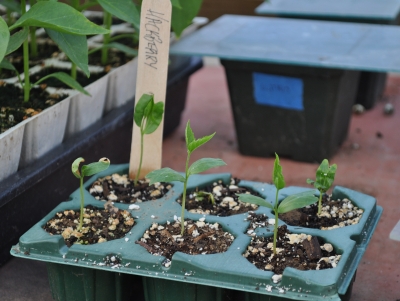
Hackberry seedlings in 2013; trees are now 15′ tall!

